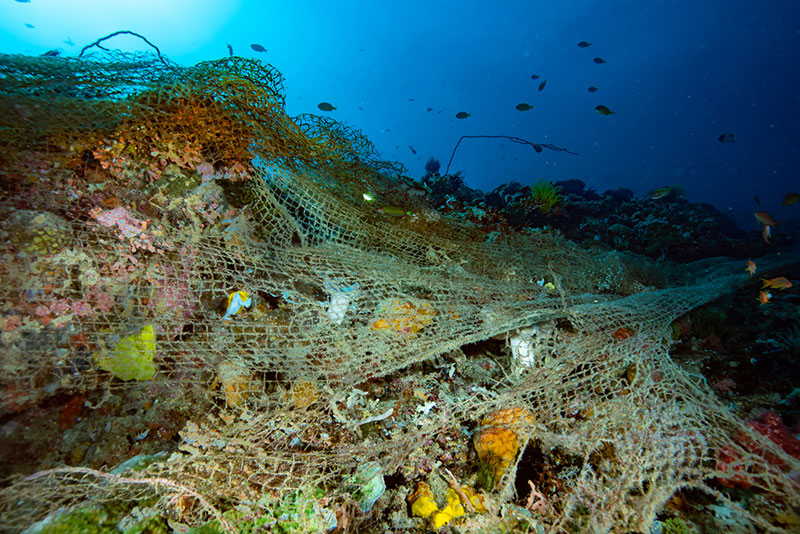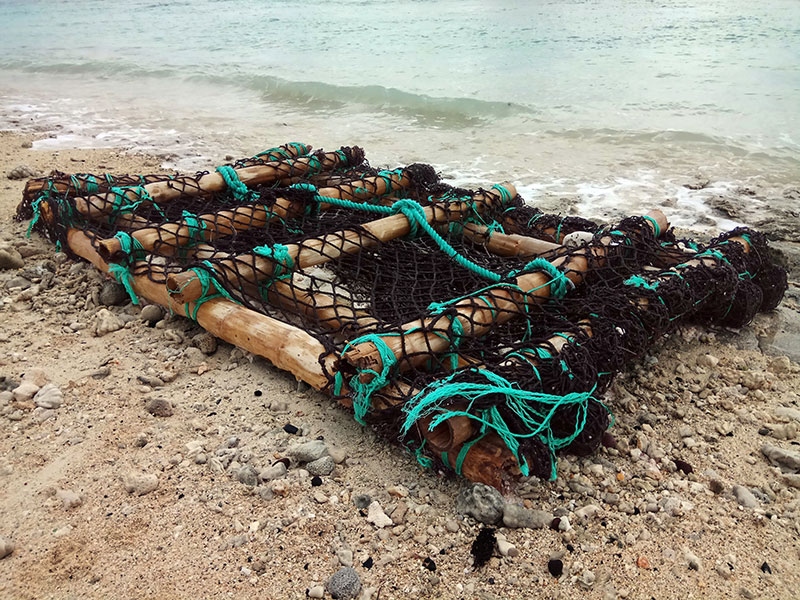Battling ghost fishing in the Indian Ocean: discover how CLS NAOS beacon help track fishing gear
- 26 March 2024
- Category: News

Ghost fishing is a significant threat to marine life and ecosystems worldwide. Lost or discarded fishing gear can remain active in the ocean for years, continuing to entangle and ensnare marine animals. It’s in this frame that CLS developed NAOS, a compact satellite buoy designed for tracking and re-locating fishing gear and prevent their loss at sea and therefore pollution.
Fishing gear pollution at sea : a real issue that need to be addressed
 Plastic pollution stemming from fishing gear in the Indian Ocean is a significant environmental concern with far-reaching consequences for marine ecosystems, biodiversity, and human well-being. Several key factors contribute to this issue:
Plastic pollution stemming from fishing gear in the Indian Ocean is a significant environmental concern with far-reaching consequences for marine ecosystems, biodiversity, and human well-being. Several key factors contribute to this issue:
- Fragmentation and Microplastic Generation: Over time, plastic fishing gear breaks down into smaller fragments due to exposure to sunlight, waves, and physical abrasion. These fragmented pieces contribute to the proliferation of microplastics in the marine environment, which can be ingested by a wide range of marine organisms, including filter feeders and plankton, potentially entering the food chain and posing risks to human health.
- Transboundary Movement: Plastic pollution from fishing gear in the Indian Ocean is not limited to coastal areas but can also impact remote and ecologically sensitive marine ecosystems, such as coral reefs, seagrass beds, and deep-sea habitats. Ocean currents can transport plastic debris over vast distances, leading to widespread contamination and ecological damage.
- Abandoned or Lost Fishing Gear: Fishing gear, including nets, lines, traps, and buoys, often contains plastic components. When these items are lost or abandoned at sea, they can continue to entangle marine life and degrade over time, releasing microplastics into the water column.
But one of the fishing gears most often lost in the ocean and which can cause damages is the FAD (Fishing Aggregating Device). It’s for this very tool that CLS has developed the NAOS.
NAOS, the CLS solution to track and monitor FAD’s (Fishing Aggregating Devices) and fishing gears
![]() Developed by CLS, a leader in satellite monitoring solutions, NAOS offers a proactive approach to tracking FADs. These floating devices are often used by fishing vessels to attract tuna and other target species, but they pose a grave risk when lost or abandoned.
Developed by CLS, a leader in satellite monitoring solutions, NAOS offers a proactive approach to tracking FADs. These floating devices are often used by fishing vessels to attract tuna and other target species, but they pose a grave risk when lost or abandoned.
NAOS beacon is equipped with satellite transmitters that relay real-time data on their location and movement. By accurately tracking FADs, authorities can swiftly intervene to retrieve lost devices or mitigate their impact on marine ecosystems. Additionally, the data collected by NAOS Beacons facilitates informed decision-making regarding fishing practices, leading to more sustainable and responsible fisheries management.
CLS relies on strong partnership and on collaborative efforts with governments, conservation organizations, and the fishing industry to deploy NAOS all over the world. Its already a success in many oceans, with deployments in the Seychelles, Australia, French Guyana, Mediterranean Sea, Vanuatu, Pacific Ocean.
By fostering partnerships and promoting the adoption of sustainable fishing practices, stakeholders can collectively address the threat of ghost fishing and safeguard the marine biodiversity of the Indian Ocean for future generations.
Economic, safety, environmental and fishing efficiency reasons: why FAD monitoring is essential
![]() Tracking fishing aggregating devices (FADs) through technologies like the NAOS can prevent their loss and subsequent negative consequences in several ways.
Tracking fishing aggregating devices (FADs) through technologies like the NAOS can prevent their loss and subsequent negative consequences in several ways.
First of all, the early Intervention for lost FADs. With real-time tracking provided by NAOS, authorities and fishing fleets can quickly identify when FADs are drifting off course or have become lost. This enables prompt intervention to retrieve the devices before they become entangled with marine life or drift into areas where they may pose hazards to navigation.
It is also an economic loss prevention for fishermen. Fishing aggregating devices are valuable tools for commercial fishing operations, helping to attract target species and improve catch rates. When FADs are lost, fishermen not only lose the initial investment in the devices but also potential income from reduced catch yields. By ensuring the timely retrieval of lost FADs, NAOS helps minimize economic losses for fishermen and supports the sustainability of their livelihoods.
Overall, by preventing the loss of fishing aggregating devices through timely tracking and intervention, NAOS Beacon technology plays a crucial role in mitigating environmental pollution, reducing economic losses for fishermen, and promoting sustainable fisheries management practices in the Indian Ocean and beyond.
 Ghost fishing remains a big challenge in the Indian Ocean, but with innovations like NAOS Beacon technology, there is renewed hope for its mitigation. By deploying fishing tracking devices on fishing vessels, scientists can gain a deeper understanding of the routes, frequency, and intensity of ghost fishing incidents. This information helps raise awareness among fishermen and facilitates the development of responsible fishing practices.
Ghost fishing remains a big challenge in the Indian Ocean, but with innovations like NAOS Beacon technology, there is renewed hope for its mitigation. By deploying fishing tracking devices on fishing vessels, scientists can gain a deeper understanding of the routes, frequency, and intensity of ghost fishing incidents. This information helps raise awareness among fishermen and facilitates the development of responsible fishing practices.
Furthermore, by sharing the collected data and insights with international organizations dedicated to ocean conservation, policymakers can make informed decisions and implement effective measures to prevent and mitigate the impact of ghost fishing.
